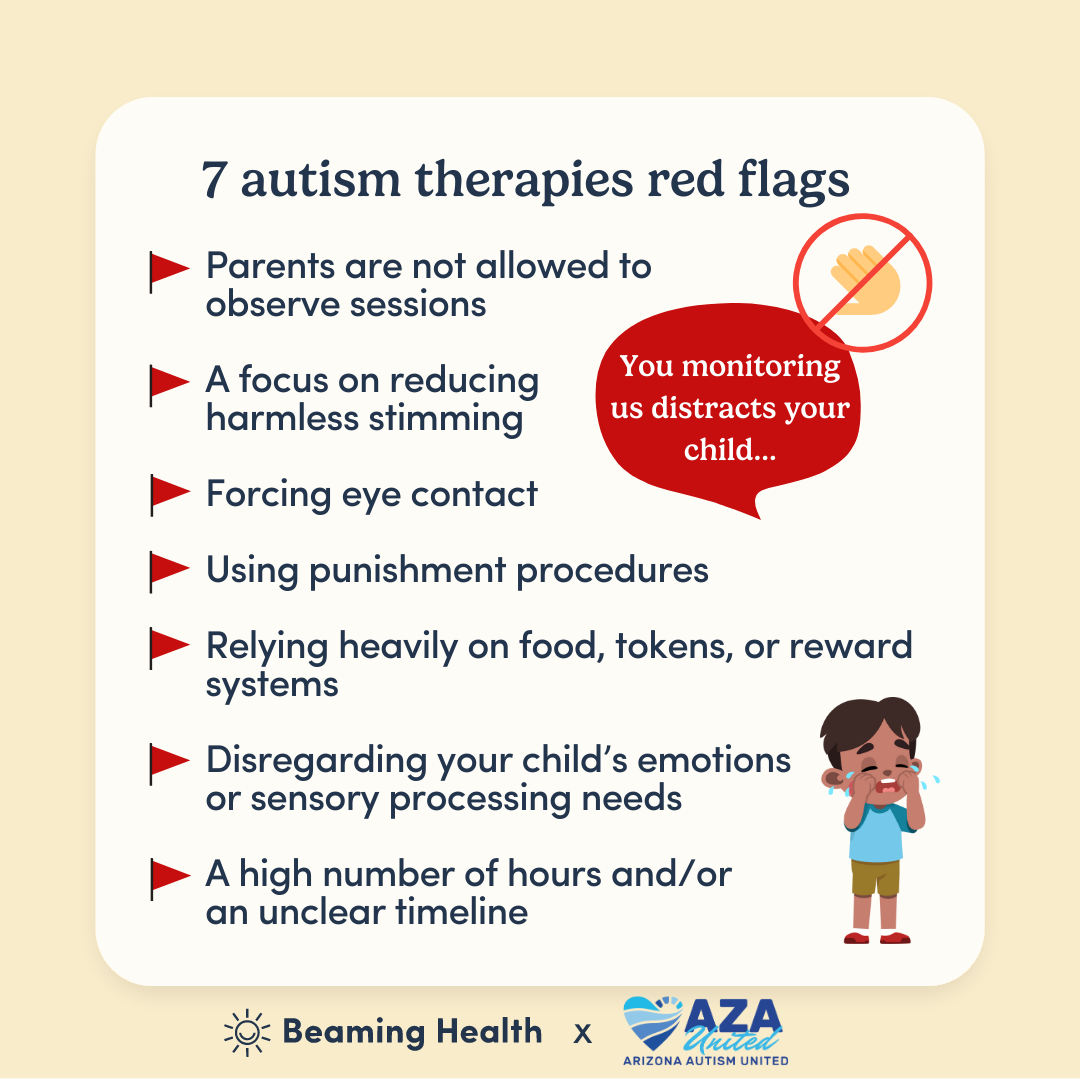ABA therapy: 14 red and green flags to consider
Updated: February 14, 2024 · 7 Minute Read

Reviewed by:
Dr. Aaron Blocher-Rubin, PhD, BCBA, and Carey Beranek, BCBA of Arizona Autism United (AZA United)
Highlights
- ABA therapy (and all therapies) should not be a one-size-fits-all approach.
- Watch out for “red flags” in an ABA program, such as not allowing parents to observe sessions, reducing or preventing harmless stimming, and forcing eye contact.
- There are also “green flags” to watch for when evaluating a provider, such as respecting individuality and close collaboration with parents and other professionals.
ABA therapy is not without controversy. While ABA can be helpful for many children, many autistic adults have voiced concerns in recent years regarding the use of ABA for autistic children.
A growing number of ABA practitioners have listened to these criticisms with an open mind and have made changes to the way they provide care. However, the field as a whole has not yet shifted toward neurodiversity-affirming, compassionate care. Here are the red and green flags to watch for when evaluating an ABA provider.
What ABA red flags should I look out for?
Red flags are signs that you may want to reconsider working with a particular ABA company or provider. If you are considering ABA for your child or if your child is currently in ABA therapy, consider the following as warning signs. If a provider demonstrates these signs, they may not be neurodiversity-affirming and may be using outdated and potentially harmful methods.

Red Flag #1: Parents aren’t allowed to observe sessions
Parents should be encouraged to observe and participate in their child’s care. If a provider tells you that you cannot join in and watch what’s going on in therapy, this is a red flag. This is particularly true of in-home ABA therapy. One of the benefits of in-home therapy is having the ability to closely monitor your child’s sessions. A provider may say “it distracts the child,” but a good therapist will work with the parent and child until the child is comfortable, rather than causing the child distress by excluding the parent. There is no valid reason for you to be excluded from your child’s session. If your child receives therapy in a clinic, there should be policies that allow you to observe your child’s therapy any time, either in-person or via video. There should never be a minute of therapy that you are not allowed to observe, because you always have the right to protect your child no matter what therapy they are receiving. HIPPA is not an excuse, either!
Red Flag #2: A focus on reducing harmless stimming
Stimming, short for self-stimulatory behaviors, is common among autistic children. However, many people believe that everyone stims to some degree. A focus on reducing stimming has historically been a key aspect of ABA therapy, but some providers have moved away from this in recent years, as autistic adults have reported experiencing pain when this natural tendency is taken away.
People stim for many reasons — excitement, frustration, and anxiousness, to name a few. Stimming is also a coping mechanism, so to stop a child from stimming gives them no outlet to soothe themselves, causing them internal distress they can’t get out (like a teapot boiling over with nowhere for the water to go). Unless your child’s stimming is harmful (e.g., repetitive head banging), there is no need to stop or redirect it. In fact, teaching kids not to stim can really hurt them in the long run, causing them trauma and in some cases, enforcing the idea that their needs, autonomy, and wants don’t matter. It can certainly be appropriate to discuss alternative behaviors that your ABA team can encourage your child to engage in if their stimming is interfering with other important opportunities. (As always, your child should be at the center of that conversation, because it’s ultimately about what will help them live the life they want.) But if your ABA provider insists on discouraging, reducing, or stopping harmless stims, this is a red flag to watch out for.
Red Flag #3: Forcing eye contact
Many autistic children and adults find eye contact to be uncomfortable or even painful. Some ABA providers, however, may insist that eye contact is an important life skill. Making and maintaining sustained eye contact is not necessary. In some cultures, it’s even considered rude or aggressive. The only exception, according to ASAN, is if the autistic person wants to learn how to fake eye contact.
The skills taught in ABA therapy should add value to your child’s life. They should not be arbitrary skills that your BCBA throws together. If your ABA provider is attempting to force eye contact or “program” your child for this skill, consider this a red flag. They are likely operating on other outdated and authoritarian practices.
Red Flag #4: Using punishment procedures
If your ABA team is using punishment of any kind, this is a major red flag. Research shows that reinforcement (such as verbal praise) is significantly more effective at changing behavior for the long-term than punishment. Oftentimes, punishment will only work at suppressing the behavior temporarily. But this does not result in long-term behavior change. Punishment fails to teach a child what they should be doing. Punishment can also have side effects, such as an increase in escape and avoidance behaviors and increased aggression. There are also ethical reasons to not use punishment, like causing trauma, increasing anxiety, and potentially contributing to depression. For this reason, many progressive ABA providers in recent years have adopted an approach known as Trauma-Assumed ABA.
Red Flag #5: Relying heavily on food, tokens, or reward systems
Using food (“edibles”) as reinforcers is still a common practice in ABA today, though many clinicians are moving away from this. Food is considered a “primary reinforcer,” which means humans innately value food. We all need food to survive. Food should be accessible without doing anything to earn it. Frequently using food as reinforcement may result in unhealthy or disordered eating habits and the development of health concerns.
Token systems (or economies) are also used to reinforce particular behaviors. Token systems can be effective at teaching delayed gratification, as we don’t always receive immediate reinforcement in life. For example, you typically work for a week or two before receiving your paycheck. A token system works in a similar way, in that the child earns tokens for specific target behaviors and then later can earn a bigger reward with those tokens. However, an overreliance on token systems is a red flag. Natural reinforcement such as smiles, praise, and attention should always be used during therapy sessions, and therapists in general should always be creative and exploratory to find in-the-moment reinforcers that your child enjoys. If your child is getting bored during therapy, the reinforcers are not working. Other examples of natural reinforcement are taking a walk outside, giving an item after asking for it, and getting help with a task after asking for assistance.
The overuse of reward systems is concerning, as it can feel very similar to classical conditioning, which is also used to train pets. Kids aren’t animals, they’re humans. Another red flag to watch for is never-ending token economies. If your ABA provider is handing out tokens, but the tokens aren’t being cashed in for anything (or nothing your child wants), that isn’t a true token system and is a sign that something is amiss.
Red Flag #6: Disregarding your child’s emotions or sensory processing needs
Unfortunately, the ABA field has a long history of ignoring a child’s emotional distress in an effort to not reinforce “challenging behaviors.” Some practitioners may also push a child to repeat a behavior or complete a task while they’re simply not able to do it — because they’re too tired, hungry, upset, or just not feeling up to it at that moment. Needless to say, simply ignoring a child when they are feeling big emotions is emotionally damaging. Some progressive ABA providers have moved away from this practice in a new movement called Compassionate Care ABA.
Whether a child is upset because they want something they can’t have, they’re feeling overstimulated, or they can’t do what’s being asked of them, there are many effective ways of working through these challenges. Teaching effective communication strategies and self-advocacy skills should be at the forefront. If your ABA provider is simply ignoring your child’s behavior until it stops, consider that a red flag. If your provider speaks or acts as if your child is just not complying, being disobedient, or uncooperative instead of acknowledging they’re having a hard time, that’s a red flag, too. (Providers in your child’s life should always presume that your child is doing their best.)
Red Flag #7: A high number of hours and/or an unclear timeline
Some providers recommend a blanket number of weekly hours for all clients. It is not uncommon for providers to encourage 30–40 hours of ABA therapy per week. There are many reasons why this is common, including insurance billing benefits, keeping a full slate of clients, and because they think more hours equals better results (it doesn’t necessarily). It is simply not true that all children need “full-time” ABA, and beware of any company that may promote this policy as a way to make more money.
The number of therapy hours should be individualized to a child’s unique needs. Your child does NOT have to participate in all the hours recommended for them. Many children are overwhelmed by attending therapies, especially if they also have school, extra-curriculars, etc. Take into consideration what works for your family’s schedule and other personal priorities you have to avoid burning your child out. Remember, although some ABA sessions feel like play, it is still work for your autistic child. If you are uncomfortable with a recommendation, don’t be afraid to advocate for a reduced number of hours or look for a different provider.
On a similar note, some ABA programs seem to be never-ending. There is a saying in the ABA field that BCBAs should aim to “work ourselves out of a job.” This means that all the goals the family and child set out to meet have been accomplished. While it is not always possible to provide an exact date that your child will end ABA therapy, a good provider will provide clear goals, with a reasonable timeline to meet those goals, plus eventual transition expectations and future discharge plans.
What ABA green flags should I look for?
There are quite a few red flags to watch out for, which may feel pretty scary for parents. The good news? There are a growing number of progressive and neurodiversity-affirming ABA providers that offer care with a family-centered approach. There are clear signs you can look for that an ABA provider is practicing compassionate and neurodiversity-affirming care. To find high quality ABA providers with ethical practices, or if you’re wondering if your provider is neurodiversity-affirming, consider these green flags:

Green Flag #1: Encouraging, but not forcing, behavior
The purpose of ABA should be to teach and reinforce helpful behaviors and skills. The focus should never be on forcing compliance. People with autism and other neurodivergence are significantly more likely to be the recipient of abuse and maltreatment, as compared to the general population.3 Forcing children to follow orders without question can be incredibly dangerous, as it primes them for abuse. When searching for an ABA provider, ask about their policies on assent and assent withdrawal. Assent based practices ensure that the child has the right to refuse to participate at any time. This requires the provider to construct an environment that is pleasant and engaging to the child. If your ABA provider believes the child has the final say in all therapy activities, consider this a green flag.
Green Flag: #2: Close collaboration with parents, caregivers, and other professionals
Parents and caregivers should be actively involved in their child’s care. This starts at intake and continues throughout the child’s therapy progression. BCBAs should include caregivers and the child in the development of goals and procedures. Rather than an expert-client dynamic, caregivers and their children should have shared decision-making. Once goals are agreed upon, caregivers should also have input on ongoing progress and the need for modifications when things aren’t working for their family.
The care your child receives should be a team effort. Some professionals get tunnel vision, believing that their method is the only way. Through open communication and collaboration, professionals can work together to develop plans that are most beneficial for the child. If your ABA provider collaborates harmoniously with your child’s other providers, this is a green flag.
Green Flag: #3: A focus on skill development for improved quality of life
Developing skills to improve your child’s overall quality of life should be the primary focus of ABA therapy, as opposed to overly focusing on behavior reduction. ABA programs that address vital life skills such as sleep hygiene, potty training, washing hands, and other skills that are important to the child and to the family can be considered a green flag.
Green Flag #4: Open communication
You should have open communication with providers. Parents and caregivers should always know what’s going on with their child’s care. They should be in the loop when changes are made, new goals are implemented, barriers to progress are occurring, staffing changes occur, and anything else that affects their child’s care.
Green Flag: #5: Each child’s individuality is respected
When ABA therapy was first implemented with autistic children in the late 1960s, the goal was “normalization.” This attitude, unfortunately, continued for several decades. The goal should never be to force a child into a neurotypical mold. This leads to masking which is incredibly harmful. Seek out ABA providers who respect and encourage your child’s individuality. Skills can be taught without changing who your child truly is.
Green Flag #6: The “why” behind the behavior is identified, and needs are met
Every behavior has a purpose. Behavior is communication. Your ABA team should conduct thorough assessments before putting any plans in place to determine the reason behind targeted behaviors. For example, if your child hits others, why do they hit? Behavioral researchers have found that many observable behaviors are reinforced by some combination of common functions, which may include attention, access to preferred items or activities, avoiding undesirable situations, sensory reinforcement, or something else. However, discovering which functions are most relevant (or “the root cause”) for a particular behavior is only the start. The ABA team has an important responsibility to make sure any recommendations will have a positive overall impact for your child (and your family). Using the example of your child hitting others, let’s imagine your BCBA determines that a relevant function is to escape from a task they don’t want to do. It is important to dive further into this to figure out what exactly they’re trying to escape. Are there things in their environment making them uncomfortable? Such as bright lights or annoying sounds? Is the task they’re being asked to do too challenging, too easy, or simply not preferred? There are so many variables that must be considered. If your ABA provider actively seeks out the “why” of your child’s behavior (which should involve asking you for insight, since you know your child best), and then implements individualized strategies to meet their unique needs, consider this a green flag.
Green Flag: #7: The child is seen as a whole person
Your child is more than their behaviors. When an ABA provider sees your child as a unique individual, they are likely to provide services as more than simply a collection of new skills. Each child has unique needs, interests, dislikes, personalities, and feelings, which must all be taken into account when providing therapy. Neurodiversity-affirming therapy services will not see your child’s autism as something that needs fixing, but as context for how to best help them.
Final thoughts
ABA therapy is not a one-size-fits-all approach, and should be personalized to your child. Look out for the red and green flags. Advocate for changes when something seems off. Find the program that best fits your child’s needs and your family’s preferences. Asking clarifying questions can ensure your child is accessing the high quality therapy possible.
Get our best articles delivered to your inbox each month.
We respect your privacy.
Dive Deeper
Article References
- How Punishment Influences Behavior. Verywell Mind. Accessed January 28, 2023. https://www.verywellmind.com/what-is-punishment-2795413#citation-3
- University of Rochester Medical Center. “Why Parents Shouldn’t Use Food as Reward or Punishment - Health Encyclopedia - University of Rochester Medical Center.” Rochester.edu, 2019, www.urmc.rochester.edu/encyclopedia/content.aspx?ContentTypeID=160&ContentID=32.
- McDonnell CG, Boan AD, Bradley CC, Seay KD, Charles JM, Carpenter LA. Child maltreatment in autism spectrum disorder and intellectual disability: results from a population‐based sample. Journal of Child Psychology and Psychiatry. 2018;60(5):576-584. doi:10.1111/jcpp.12993













